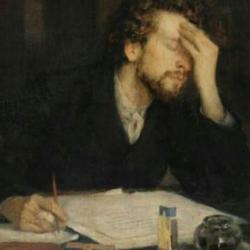I want to examine Bunyan’s Pilgrim’s Progress and Daniel Defoe in the context of the rise of the Western European novel. Some scholars suggest that novel-like writing is evident in the ancient world, in medieval Japan, and medieval Europe. But the novel-writing that began to take over Europe in the 17th century was historically unique, and has become the chief genre of fiction writing in the modern world.
A novel is a long prose work in which the main characters and events are not real characters and events, a long prose fiction. This definition sets the novel off from earlier long works of literature, which were in the main written in verse rather than prose. Milton is the last to write a major poetic epic, and even in his day it was something of a quixotic endeavor. This definition, obviously, also sets the novel off from history and biography. Though there are various forms of the novel that blur this distinction, such as the historical novel, and even many works that would not be considered historical novels assume a real historical background and include references to real historical events and characters. Yet, even the most historical of historical novels take liberties with character and events, and are not offered as an accurate description of the facts.
We should be more surprised by the dominance of the novel in modern literature than we are. Even if we can say that something like novels existed in the ancient world or in the east, the dominant forms of literature were poetic rather than prose. The shift from epic poetry to the novel is one of the key marks of the shift from ancient and medieval to modern literature. Shakespeare, though not writing epic, is still writing poetry, as are many of the major English writers until the 18th century. It seems to me that it reveals something quite profound about the character of the modern age. What it reveals is pretty hard to determine, but it is remarkable to realize that the novel as we know it began to rise in the seventeenth century, and has since drive every other genre from the field. Nothing today rivals the novel in its popularity or number of publications or visibility. No poet today has anything close to the popularity of a John Grisham, nor even of a more serious novelist like John Updike. There is a lot of poetry written today, perhaps more than ever before, but it does not have the same cultural position that poetry had in the past.
I want to look briefly at the origin of the English novel, and highlight some of the important early developments. In particular, I want to explore some of the technological, social, cultural and religious circumstances surrounding the rise of the English novel. I do not claim that these changes and developments were “causes” for the rise of the novel. But it is a simple historical fact that the English “novel” as a form of writing appeared in the early modern period, and it appears that the novel “fits” with other developments.
First are technological changes, especially in the media of communication. In particular, the early modern period witnessed a shift from a largely oral to a largely written culture. When Samuel Pepys wanted to know the latest news, he hung out at Court, spent time at Westminster, or had a drink at a nearby tavern. But over the course of the later 17th and early 18th centuries, news and gossip increasingly came through the written word. The invention of movable type and the easy production of books had shifted the setting for literary performance. Movable type preceded the rise of the novel by well over a century, but it provides crucial background. At the most obvious level, movable type made books more widely available and cheaper. The exploitation of the printing press did not really take hold until the middle of the 17th century: “Only in the great upheavals of the 1640s and 1650s did printed materials — pamphlets, ballads, handbills, and the like — begin to reach anything approaching a large audience in London.” Printing revived again in other periods of crisis, such as that around 1688, but it’s not until the 1690s that we see a real accelerated growth in the production of printed materials, including magazines and newspapers.
Along with this was an increase in literacy, which created a wider reading public. Readers were no longer confined to the elites, or to the clergy. More and more, the common man was becoming a reader. There is evidence that the rise in literacy was especially marked among women. Peter Laslett (in “The World We Have Lost”) notes that after the Marriage Act of 1753, each bride and groom were required to sign or make a mark in the marriage register. A survey of Yorkshire parishes showed that 2/3 of the grooms could write their names in the 1750s, but less than half the brides. A hundred years later, the proportion of bridegrooms who could sign their names had risen to 75%. In another area of England, no woman signed the marriage register (at Crulai) prior to the 1680s, but after 1740 there was a rapid rise to over half. Laslett suggests that this was mainly due to the opening of a school for girls in the village around this time.ii) Book ownership has been measured. It is almost impossible to determine book ownership prior to the mid-17th century, and even after, wills provide the best evidence. But there seem to be too few to account for the size of the book industry. Laslett notes: “in Leicestershire in the 1620s-1640s, 17 per cent of all willmakers left books, and 50 per cent of the gentry. That even modest craftsmen could and did own serious and difficult works has recently been demonstrated in the area of Glasgow in Scotland in the 1750s, where farmers, showmakers, and even coalhewers, but especially textile workers and above all weavers, are now known to have paid good money in order to buy, and presumably to read serious works of theology.”
With a book-buying public that now included weavers and textile workers, rather than scholars, there was pressure to write to popular tastes. The tastes at times run in the area of theology, and devotional literature like Bunyan. But popular tastes also ran in the direction of sensational romances. Most especially, a reading public like that of the late 17th and early 18th century were not inclined to favor poetry, which is more difficult to read. Bunyan’s popularity is not surprising; but it would be surprising if the masses flocked to get copies of Spenser or Milton.
This change in the form of literary works affected the way literary works were written. The wider distribution and the new medium of the disposable book had important effects on the way literature was read. Not only were there important changes in the distribution and readership of books; there was a change in the context for literary “performance.” Perhaps more accurately, the change was a matter of moving from literary performance to reading. Literature was no longer a public act (as it was for epic poets of the ancient world, for instance) but a private and impersonal communication.
Elizabeth Eisenstein, who has written some books on the cultural impact of the printing press, linked the change from oral to printed medium with secularization, individualization, and atomism of modern society: “in all regions . . . the pulpit was ultimately displaced by the periodical press, and the dictum ‘nothing sacred’ came to characterize the journalist’s career. Pitted against ‘the furious itch of novelty’ and the ‘general thirst after news,’ efforts by Catholic moralists and Protestant evangelicals, even Sunday schools and other Sabbatarian measures proved of little avail . . . . By the last century, gossiping churchgoers could often learn about local affairs by scanning columns of newsprint in silence at home.” Eisenstein also suggested that the
dominance of written literature weakened community ties: “To hear an address delivered, people have to come together; to read a printed report encourages individuals to draw apart . . . The wide distribution of identical bits of information provided an impersonal link between people who were unknown to each other”; “To be sure, bookshops, coffeehouses, reading rooms provided new kings of communal gathering places. Yet subscription lists and corresponding societies represented relatively impersonal group formations, while the reception of printed messages in any place still required temporary isolation — just as it does in a library now. The notion that society may be regarded as a bundle of discrete unites or that the individual is prior to the social group seems to be more compatible with a reading public than a hearing one” This privatization of reading and literary experience also favored the novel over the poem. Poetry is essentially an oral art. The poet is as concerned about the music of his words as he is about the sense (though the two are not entirely separable). With the widespread distribution of books, the reading public is more dispersed, individualized, private; literary experience is reading in an easy chair rather than attending a theatrical performance or a public reading. These are not exclusive, but the particular experience that is associated with the novel is a private one.
Another factor was early capitalism. Trade in books was becoming big business, because of the ease of printing and the rising literacy rates. William Warner writes that “the market in printed books offered a site for the production and consumption of a very broad spectrum of entertainment . . . . Novels were the first ‘disposable’ books, written in anticipation of their own obsolescence and in acceptance of their own transient function as a part of a culture and serial entertainements . . . .novels appear to have been the most high-profile, fashionable, and fastmoving segment of the market.” Critics noted the parallels between the novel and the market: “both breed imitation, gratify desire, and are oblivious to their moral effects.” Given this expanding market for novels, imitation was widespread, and any successful novel was followed by spinoffs by other writers (and also often by parodies).
There were also reasons why the English novel took the distinctive form it did. In part, this was due to philosophical developments that filtered into culture. The rise of Cartesian rationalism made the emotions problematic. Philosophy was the preserve of reason, and the development of a mechanistic, Newtonian science reinforced this separation by associating scientific enquiry with dispassionate philosophical investigation. Emotions and particularity were left to literary expression. Romanticism in poetry and sentimentality in novels are both reactions to rationalism and the rise of scientism. Stephen Toulmin observes that the novel, despite its emphasis on sentiment, is the obverse side of rationalism: “Descartes exalted a capacity for formal rationality and logical calculation as the supremely ‘mental’ thing in human nature, at the expense of emotional experience, which is a regrettable by-product of our bodily natures. From Wordsworth to Goethe on, romantic poets and novelists tilted the other way: human life that is ruled by calculative reason alone is scarcely worth living, and nobility attaches to a readiness to surrender to the experience of deep emotions. This is not a position that TRANSCENDS 17th-century dualism: rather, it accepts dualism, but voes for the opposite side of every dichotomy.” This is close to what Eliot called the “dissociation of sensibility,” the separation of reason and emotion, that Eliot believed occurred in the early modern period.
Puritanism was a significant factor in the rise of the English Novel in particular. Edward Said claimed that the novel is a specifically Christian form of writing. It presupposes a world that is incomplete, that is yearning for salvation, and moving toward it. By contrast, he claims, the world of Islam is a closed and complete world, and therefore the novel form, with its dynamism and movement, cannot arise there, until touched by Western literature. Whatever the truth of this general claim, it is a simple fact that some of the earliest “novellike” works in English were produced by Christians, specifically by Puritans. Here I get finally to the contributions of Bunyan and Defoe. Pilgrim’s Progress is, as someone has remarked, an allegory that is constantly attempting to burst into a novel, and Robinson Crusoe is a novel that continually threatens to collapse into allegory. I want to explore these two writers, their similarities and differences, and the way they both contributed to the development of the English novel’s particular concerns and emphases. In a standard account of the development of English literature, these books and these two writers are seen to be quite different in outlook and intention. Bunyan was a Puritan writing an edifying allegory, while Defoe was writing an adventure story, which many have described as the “first novel.” I want to suggest instead that they are much more similar than we usually recognize, and their common concerns are an important part of the background for the rise of the novel.
By employing an allegorical method, Bunyan in one sense followed a long-standing tradition of Western and English letters, going back at least to William Langland and the morality plays of the medieval period, and reaching its climax in Spenser’s Fairie Queene. But even the slightest acquaintance with Spenser and Bunyan shows that Bunyan’s allegory was far different form Spenser’s. Spenser’s plots are exceedingly complex, and there are always several layers of allegory operating simultaneously (personal development of virtue, political allegory, English history, England’s religious struggles, etc.). Bunyan is much more straightforward; each character is transparently named and means basically one thing. One of the differences has to do with the impression of “realism” and naturalism that we get from the characters. Although his characters are allegorical figures, they have a roundness that Spenser’s lack. We come away thinking we know Mr. Worldly Wiseman, when it’s hard to say we have gotten to know the Redcrosse Knight or Sir Guyon.
If Bunyan’s methods of writing were different from the methods of earlier allegorists, they seem equally different from the methods of a “realistic” writer like Defoe. Again, even a passing acquaintance with the two books makes this clear. A portion of Defoe’s book is written as a journal of Robinson’s daily activities on the island. The entry for Nov. 18 reads in part: “The next day in searching the woods I found a tree of that wood, or like it, which in the Brasils they call the iron tree, for its exceeding hardness; of this, with great labor and almost spoiling my axe, I cut a piece, and brought it home too with difficulty enough, for it was exceedingly heavy.” If this symbolizes something, it is certainly not clear what. It appears to be simply a realistic description of what a man stranded on a desert island might do for a day. Christian the Pilgrim, however, cannot make a move without doing something allegorical. Christian too has some dealings with a tree, following his battle with Apollyon. But this is the “tree of life,” and the leaves of that tree heal Christian of his wounds. He then sits to eat and drink and continues his journey, but certainly that eating and drinking is not “realism” but another allegorical note. Following the battle with the monstrous opponent, it is necessary for the Christian to take refreshment. Perhaps the clearest illustration of the overt differences between the two boo
ks has to do with the primacy and overtness of theology. If Bunyan doesn’t permit Christian to act non-allegorically, he also does not allow him a single frivolous or purely “secular” conversation. Robinson Crusoe doesn’t talk much to anyone, but his discourse and thoughts are filled not only with thoughts of Providence and his sin, but with the practical needs of the moment.
Yet, I want to suggest that the two books are far more similar than they might appear to be, and that there is a rather small (though momentous) step from Bunyan to Defoe. And I also want to suggest that Defoe is the far better theologian of the two. One similarity becomes evident when we recognize the extent to which Defoe employs biblical categories and allusions to describe Robinson’s life and history. Early in the novel, Robinson is a Prodigal Son who sins by despising parental and other authority; a Jonah who refuses to go where the Lord wants him to go and ends up drenched in the sea. Defoe bleeds bibline nearly as much as Bunyan pricked. There is also Defoe’s obvious concern with the spiritual condition of his character. Robinson is a rebel early in the novel, and his obstinence is directed not only as his father but also at his Father. He ignored the Providential signs that should lead him along a different path of life. When he gets on the island, his attitude to Providence begins to change, and instead of bucking against Providence he begins to show gratitude for all that the Lord has brought to him. At the climax of this development, Crusoe converts in the midst of a deathly illness. Crusoe has, in short, his own wicket gate. Bunyan is obviously presenting a morphology of conversion; but Defoe is doing the same, though the adventure context distracts many readers into thinking otherwise.
Behind both Bunyan and Defoe is a tradition of Puritan (but not only Puritan) spiritual autobiography, and this tradition has, through these two writers, an incalculable effect on the development of the English novel. A number of the features of these autobiographies (some of which were published, others of which were circulated in manuscript) are evident in the two novels. (I am dependent here on the fine 1965 study by G.A. Starr, Defoe and Spiritual Autobiography.) The Puritans defended their interest in taking account of their spiritual progress (or decline) in several ways. On the one hand, they often used economic metaphors, comparing the Christian to a spiritual merchant who should take stock of his accounts every day to see if he is making a profit. They also recognized that each human being, though unique, faced similar challenges and temptations to all other human beings (temptations, Paul said, are “common to man”), and so an account of one sinner’s progress in holiness would be edifying to others. This attention to personal development and progress has an important, often secular, manifestation in the novel’s emphasis and interest in character development. Stories of character development are stories of sanctification (or, desanctification as the case may be). Though not making the theological dimension explicit, a Jane Austen heroine struggles to discern the shape and progress of her life as much as a Puritan journal-writer.
Puritans were instinctive allegorists (or, perhaps better, tropologists), turning all created things, all human activities, and every event into some sort of moral allegory. One minister was celebrated by his biographer for his ability to see a message in everything: “each Tree, and Bird, and Stone, would be a Text whereon he would aptly inlarge; having a mighty wit for the Spiritualizing of every thing, and gathering occasion of good Converse in every Company, and upon every matter.” A 1682 volume by Benjamin Keach and Thomas Delaune, aptly entitled Tropologia, attempted to explain biblical metaphors and to spiritualize all of life. In this respect, Robinson Crusoe is actually closer to the Puritan outlook than Bunyan. Puritan spiritualization moved from a “natural” phenomenon to a spiritual lesson, which is the spiritual and intellectual move that Robinson Crusoe has to learn to make – to see meaning in the works of Providence. In Pilgrim’s Progress, however, there simply is no natural world upon which to tropologize. Defoe’s more robust attention to and love of this world is one of the important clues to his theological difference from Bunyan.
The plot structure of both Pilgrim’s Progress and Robinson Crusoe also owes a great deal to the symbolics of Puritan autobiography. The notion that the Christian life is a journey is an ancient one, but the Puritans were also inclined to see the Christian life as a voyage. As Starr puts it, “The Christian must pilot his soul with the alertness of a mariner: just as frequent soundings, diligently recorded, enable ships to avoid rocks and quicksands, so constant vigilance and reflection keep one clear of spiritual perils. A kindred analogy was used to illustrate autobiography’s double instructiveness to author and reader. A ship’s log is useful to him who keeps it and to others, should the voyage ever be repeated. Since every man is embarked on essentially the same spiritual journey, the record of one will be of use to all.” In short, it is no accident that Defoe’s book actually becomes a dated journal for some dozens of pages. He is imitating a well-known genre, though again the allegorical and spiritual dimensions are less overt than in spiritual autobiography. Starr argues that, though Defoe drew on many sorts of sources for his book, Robinson Crusoe and Defoe’s other novels “are as strongly influenced by a long tradition of spiritual autobiography.”
Autobiography and the self-scrutiny required to produce it, reinforce and reflect the individualistic strain inherent in Puritanism. Both Crusoe and Bunyan reflect this same tendency. Bunyan’s Christian leaves his family behind to go it alone. He occasionally meets up with allies along the way, and these “two gathered” are the most “ecclesial” that Bunyan gets. (Part II of Pilgrim’s Progress has a more corporate character, with a traveling band of pilgrims rather than a solitary one.) Crusoe’s conversion is a very Protestant conversion – sola Scriptura, without mediator, priest, or sacrament. In part, this individualistic strain arises from a sense of the danger of the external and social world. The world is “Vanity Fair,” where everything has its price, and the way of salvation is the way of exodus from the city of destruction. Bunyan’s heroes are all lower-middle-class, and anyone with a waistcoat or a hint of frill is suspect from the outset. By its nature, Defoe’s book is less overt in its social critique than Bunyan is, because Crusoe never encounters society. But the hints that we get suggest that Defoe is less suspicious of civilized society than Bunyan. Though often read as a primitivist, it is clear that Defoe placed his hero on his island with all sorts of benefits derived from the civilization from which he is cut off. He recovers what he can from the ruins of the civilization, and begins to rebuild middle class English society on his island – fulfilling his father’s instructions in spite of himself. The course of Crusoe’s post-conversion life also illustrates Defoe’s more favorable attitude toward creation. After Crusoe’s conversion, he leaves his underground home (he’s been living in a cave, a grave), moves across the island to an Edenic setting and builds a tree house, above the ground. He begins to domesticate animals. He is, in short, converted to be a new Adam, not to escape civilization but to rebuild it on a more pure foundation.
By the 18th century, the story of conversion and sanctification has become a story of character development; the concern for Providence ha
s become a secular concern for the meaning of events and objects in the world; and the social critique that is often near the heart of the English novel has lost its theological moorings. Yet, in certain fundamental respects the English novel is a secularization of Puritan autobiography, mediated through the allegory of Bunyan and the adventure-allegory of Defoe.















